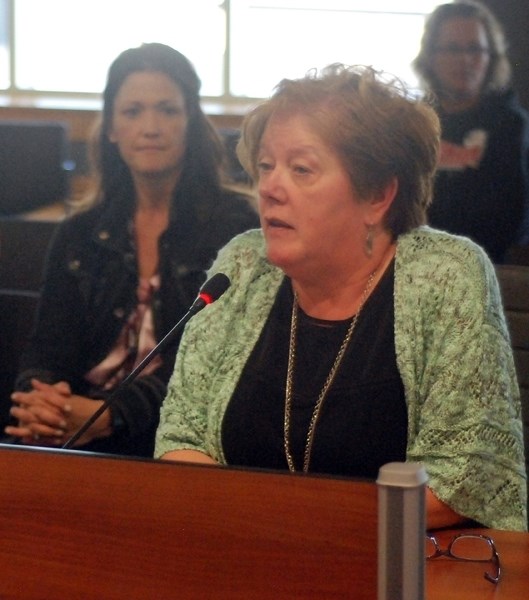An Alberta Health Services representative recently presented town officials with data that paints a clearer picture on the services provided by the Sundre Hospital and Care Centre.
Cathy McDonald, AHS senior operating officer for South, Central Zone, said during council's April 18 meeting that she brought some facts about the facility to highlight what the staff at the hospital does for the community and surrounding region.
However, McDonald went on to add that she did not have immediate answers regarding the closure of the 15 long-term care beds at the facility.
"But I certainly come with the perspective that we could have a discussion."
Providing background on the hospital, she started with the most recent figures on the region's population, which as of 2014 stood at about 6,800 people, representing a growth of almost five per cent since 2004.
"We're seeing some growth in the area," she said.
However, "the growth in this area is not as rapid as in the rest of the province."
A noteworthy statistic is the fact that 18.8 per cent of the residents in Sundre's geographical area are 65 or older, she said.
"That's 7.5 per cent higher than the average in Alberta."
Although rural Albertans had a lower life expectancy than their urban counterparts just years ago, statistics are showing that trend is reversing in this area, she said.
"People born in Sundre today are expected to live an average of 81.7 years, compared with a provincial life expectancy of 81.1 years."
Alberta Health Services provides various levels of hospitals, from quaternary centres such as the Foothills Medical Centre in Calgary or the University of Alberta Hospital in Edmonton, tertiary centres that are mainly in cities, as well as regional centres such as the ones in Red Deer, Grande Prairie and Lethbridge, she said.
"And then we have a large network of community hospitals within the province, which Sundre would fall into."
Although the Sundre hospital provides three out of five core critical services, it does not offer surgical services or endoscopy, which some rural hospitals do, she said.
"Over the last five years, we've averaged between 9,500 to 10,000 visits to our emergency department per year," continued McDonald.
In 2014-15, there were 9,472 visits from 4,733 distinct patients, whose average age was 43, she said.
"We see 26 emergency patients in 24 hours."
Although night shifts can sometimes be hectic, the overall average is one visit, she said.
When a patient visits the emergency department, the severity of the case is always looked at, she said, adding that about 25 per cent of those who come in are considered to be in either an urgent, emergency or resuscitation category.
More than one-third of the hospital visitors come from outside of Sundre's local geography, she said.
"That's really to be expected given the population and recreational population that we serve in Sundre. That's higher than what we would typically see."
The expense of operating the emergency department, which does not include the costs for the lab, X-rays, the pharmacy nor physicians, runs up to about $3 million per year. There are 14 in-patient beds, six private and four semi-private beds. When it's not being used for obstetrics, a labour and delivery room is also used as an in-patient room, which is counted among the 14, she said.
More than 80 per cent of admissions are medical, about 10 per cent are obstetrical, roughly four per cent are related to addictions and mental health while approximately two per cent are palliative, she said, adding some 40 per cent of the patients who comes through the doors are more than 75 years old.
The average length of stay in the hospital is shy of seven days, and the top reasons for hospitalization in Sundre are heart disease and respiratory diseases like influenza and pneumonia, she said.
The hospital's average occupancy rate is 84 per cent, which is within the number AHS aims for, she said.
"We think that' s a very healthy occupancy rate."
If a hospital's occupancy is less than 75 per cent, that means there are too many beds for the population being served. On the other hand, if the occupancy is more than 85 per cent, there will likely be bed shortages, she said.
"Even at 84 per cent, there are times when occupancy does reach 100 per cent. There have been times when we've been over capacity and had to refer people to other hospitals."
In any given year, McDonald said she found it interesting that six to 10 per cent of the hospital's patients are considered long stay ó they account for 38 - 48 per cent of hospitalization days.
In 2014-15, the cost of operating the in-patient unit was about $3.9 million. Obstetrics cost about $92,000 and palliative care was about $421,000, she said, reiterating these costs do not include lab services, X-rays and physicians.
After adding up the overall costs, more than $7 million is annually being invested in the hospital, largely to cover the payroll, which accounts for approximately 70 per cent of the total expense, she said.
McDonald told council she wanted to present that information "because I think it really does emphasize the important role that the hospital plays in providing acute care, emergency and ambulatory type services for this community."
The data emphasizes the fact the facility provides a vital, core service for the community and region, she said.
She has heard fears expressed from the community that Alberta Health Services will shut down further services at the hospital, but that's not in the cards because "what's being provided needs to be here."



